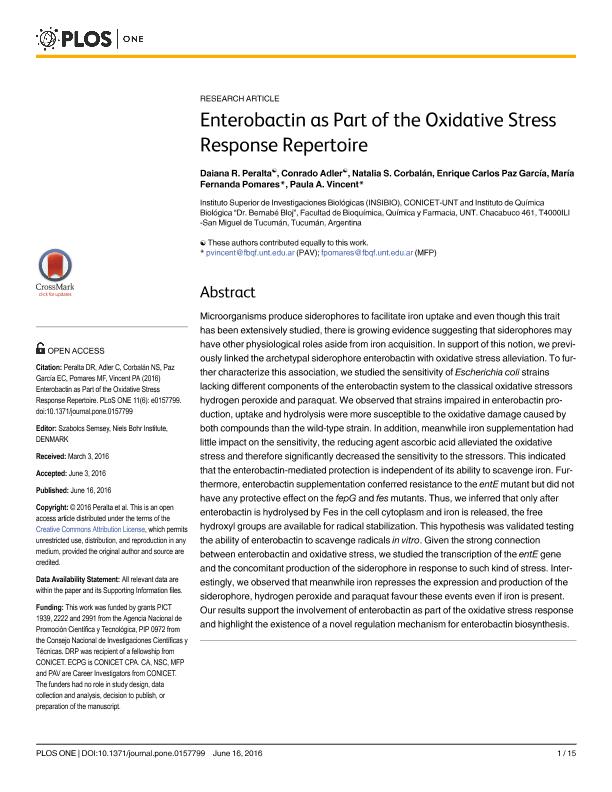Artículo
Enterobactin as part of the oxidative stress response repertoire
Peralta, Daiana Romina ; Adler, Conrado
; Adler, Conrado ; Corbalan, Natalia Soledad
; Corbalan, Natalia Soledad ; Paz García, Enrique Carlos
; Paz García, Enrique Carlos ; Pomares, Maria Fernanda
; Pomares, Maria Fernanda ; Vincent, Paula Andrea
; Vincent, Paula Andrea
 ; Adler, Conrado
; Adler, Conrado ; Corbalan, Natalia Soledad
; Corbalan, Natalia Soledad ; Paz García, Enrique Carlos
; Paz García, Enrique Carlos ; Pomares, Maria Fernanda
; Pomares, Maria Fernanda ; Vincent, Paula Andrea
; Vincent, Paula Andrea
Fecha de publicación:
06/2016
Editorial:
Public Library of Science
Revista:
Plos One
ISSN:
1932-6203
Idioma:
Inglés
Tipo de recurso:
Artículo publicado
Clasificación temática:
Resumen
Microorganisms produce siderophores to facilitate iron uptake and even though this trait has been extensively studied, there is growing evidence suggesting that siderophores may have other physiological roles aside from iron acquisition. In support of this notion, we previously linked the archetypal siderophore enterobactin with oxidative stress alleviation. To further characterize this association, we studied the sensitivity of Escherichia coli strains lacking different components of the enterobactin system to the classical oxidative stressors hydrogen peroxide and paraquat. We observed that strains impaired in enterobactin production, uptake and hydrolysis were more susceptible to the oxidative damage caused by both compounds than the wild-type strain. In addition, meanwhile iron supplementation had little impact on the sensitivity, the reducing agent ascorbic acid alleviated the oxidative stress and therefore significantly decreased the sensitivity to the stressors. This indicated that the enterobactin-mediated protection is independent of its ability to scavenge iron. Furthermore, enterobactin supplementation conferred resistance to the entE mutant but did not have any protective effect on the fepG and fes mutants. Thus, we inferred that only after enterobactin is hydrolysed by Fes in the cell cytoplasm and iron is released, the free hydroxyl groups are available for radical stabilization. This hypothesis was validated testing the ability of enterobactin to scavenge radicals in vitro. Given the strong connection between enterobactin and oxidative stress, we studied the transcription of the entE gene and the concomitant production of the siderophore in response to such kind of stress. Interestingly, we observed that meanwhile iron represses the expression and production of the siderophore, hydrogen peroxide and paraquat favour these events even if iron is present. Our results support the involvement of enterobactin as part of the oxidative stress response and highlight the existence of a novel regulation mechanism for enterobactin biosynthesis.
Archivos asociados
Licencia
Identificadores
Colecciones
Articulos(INSIBIO)
Articulos de INST.SUP.DE INVEST.BIOLOGICAS
Articulos de INST.SUP.DE INVEST.BIOLOGICAS
Citación
Peralta, Daiana Romina; Adler, Conrado; Corbalan, Natalia Soledad; Paz García, Enrique Carlos; Pomares, Maria Fernanda; et al.; Enterobactin as part of the oxidative stress response repertoire; Public Library of Science; Plos One; 11; 6; 6-2016; 1-15; e0157799
Compartir
Altmétricas



